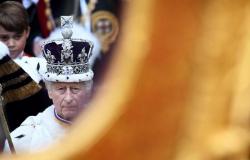Artists, sure. But also billionaires, collectors and curators. The Russian Pavilion at the Biennale Gardens was handed over to Boliviabut the Russian world that revolves around art, and the world of business, was well represented in Venice during the inauguration days of the 60th International Exhibition. Almost as if nothing had happened.
The yacht Odessa II of the tycoon Len Blavatnik – former partner of the oil giant Tnk-BP acquired by Rosneft, now owner of Warner Music Group with his Access Industries, long since moved to Great Britain, then to the United States – remained docked almost all last week at the Zattere, a few steps away from the Venetian headquarters of the VAC Foundation financed by Leonid Mikhelson, owner of Novatek, an important Russian group in the gas and space sector and closed since the beginning of the war against Ukraine.
Collector Inna Bazhenova, an entrepreneur with interests in the oil and gas sector, launched the digital art platform Taex at Scoletta after the transfer of technologies from aeronautics to the mining sector in the early 1990s dei Battioro and Tiraoro in Campo San Stae, on the Grand Canal. Among the numerous Russian guests at the inauguration of the exhibition “Scoletta dell’arte: Digital Reform”, Olga Sviblova, director of the Moscow Museum for Multimedia Art Mamm, which has just reopened after a long renovation.
And two of the artists of the AES+F collective of which both Blavatnik and the IT entrepreneur, Aleksandr Popov, still living in Moscow and also spotted in Venice these days, are collectors. In 2007 their work “Last Riot” was chosen for the Russian Pavilion at the Biennale. On the day the invasion against Ukraine began, AES+F had added a black background to their Instagram account, signed an anti-war petition, “and started to keep quiet.” “Not a silence of conformity or agreement. But of shock and impotence”, the artists wrote in a statement from Berlin, where they live. Daria Pushkova, director of the Russian Center for Science and Culture in Rome, also participated in the inauguration of the first Taex initiative.
Champagne and chat. Digital works by six contemporary artists and as many ‘classics’, including Théodore Géricault and Kazimir Malevich, drawings and paintings from the private collection of the patron originally from Nizhi Novgorod, who moved to Monte Carlo some time ago with her husband Dmitry Samorukov, and last autumn it sold Art Newspaper, which it had purchased in 2014, to Hong Kong’s AMTD group. “Digital Art Makes History Too” and Come and Play with Us” are the neon signs mounted on the facade of the building built at the beginning of the eighteenth century.
The future? “Impossible to predict.” “But I was born in Moscow and I’m not leaving”, commented one of the guests. “Yesterday we met again after two years, happy to see each other again and to be in Venice – explains another of the personalities present speaking to Adnkronos – But our world of contemporary art is not the same as before, even if Moscow is full of of exhibitions and initiatives”. The public contributions from the State that rained down on society in these years of war must have also affected the art sector.
Return to a principle of reality the next day at the itinerArte Gallery in Dorsoduro, where Andrey Bilzho artist, author and illustrator well known in his country for the character of Petrovich, opened the “oddlander” exhibition, golden shoes at the foot of the chairs , a child’s bed with a Soviet ceremonial flag as a blanket, tables lacquered with traditional Russian techniques, animal characters and many drawings on the walls, many of them about war and repression in Russia.
“This is my universe. I moved it here”, explains the artist to Adnkronos, “born three months after Stalin’s death in a family of enemies of the people” and who, since the beginning of the invasion, has he moved permanently to Venice, where he lives with a visa to be renewed every year which does not allow him to work and a house like his exhibition. A psychiatrist before dedicating himself completely to drawing, in the days following February 24, 2024 he listened on the phone, trying to contain them, to the traumas of his Ukrainian contacts.
Almost all of his guests have left Russia, like him. Including Marat Gelman, foreign agent since 2021 and on the list of wanted people in Russia since the following year, former political advisor to the Kremlin and director of the Museum of Contemporary Art in Perm, well-integrated curator until the early 2000s. In 2014 he moved to Montenegro, now lives in Berlin, where he opened a gallery that donates part of his income to Ukrainian funds. And he just presented the exhibition “Blue Lard” cancelrussianculture “by the writer Vladimir Sorokin in New York.
There are also many Russians among the visitors of the exhibition set up at Cà Foscari “Uzbekistan: the Avant-garde in the desert. The form and the symbol”, also open close to the inauguration of the Biennale and curated by the director of the Csar, Center for studies on Russian art, Silvia Burini, at the center of controversy in 2014 for having conferred and delivered to Moscow, she was then vice-rector of the Venetian university, a recognition to the then Minister of Culture Vladimiv Medinsky, and having received, in turn, a few months later in the Kremlin, the Pushkin Prize. Just as there are many Russians walking in the streets or sitting at a table in a restaurant in the city. Maybe after reading “Moia Venezia – 2”, the “alternative guide” signed by Bilzho. (from correspondent Simona Poidomani)
Tags: Venice Art Biennale billionaires collectors tourists Russia





